
Jordanes, also written Jordanis or, uncommonly, Jornandes, was a 6th-century Eastern Roman bureaucrat of Gothic extraction who turned his hand to history later in life.
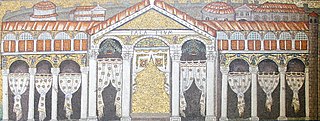
The Ostrogoths were the eastern branch of the older Goths. The Ostrogoths traced their origins to the Greutungi – a branch of the Goths who had migrated southward from the Baltic Sea and established a kingdom north of the Black Sea, during the 3rd and 4th centuries. They built an empire stretching from the Black Sea to the Baltic. The Ostrogoths were probably literate in the 3rd century, and their trade with the Romans was highly developed. Their Danubian kingdom reached its zenith under King Ermanaric, who is said to have committed suicide at an old age when the Huns attacked his people and subjugated them in about 370.

The Visigoths were the western branches of the nomadic tribes of Germanic peoples referred to collectively as the Goths. These tribes flourished and spread throughout the late Roman Empire in Late Antiquity, or what is known as the Migration Period. The Visigoths emerged from earlier Gothic groups who had invaded the Roman Empire beginning in 376 and had defeated the Romans at the Battle of Adrianople in 378. Relations between the Romans and the Visigoths were variable, alternately warring with one another and making treaties when convenient. The Visigoths invaded Italy under Alaric I and sacked Rome in 410. After the Visigoths sacked Rome, they began settling down, first in southern Gaul and eventually in Hispania, where they founded the Visigothic Kingdom and maintained a presence from the 5th to the 8th centuries AD.

Decius, also known as Trajan Decius, was Roman Emperor from 249 to 251.

Flavius Ardabur Aspar was an Eastern Roman patrician and magister militum of Alanic-Gothic descent. As the general of a Germanic army in Roman service, Aspar exerted great influence on the Eastern Roman Emperors for half a century, from the 420s to his death in 471, over Theodosius II, Marcian and Leo I, who, in the end, had him killed. His death led to the ending of the Germanic domination of Eastern Roman policy.

Aemilianus, also known as Aemilian, was Roman Emperor for three months in 253.
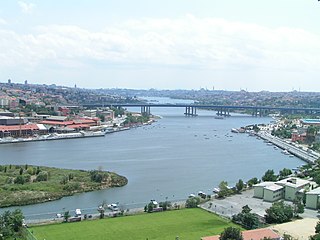
De origine actibusque Getarum, or the Getica, written in Late Latin by Jordanes in or shortly after 551 AD, claims to be a summary of a voluminous account by Cassiodorus of the origin and history of the Gothic people, which is now lost. However, the extent to which Jordanes actually used the work of Cassiodorus is unknown. It is significant as the only remaining contemporaneous resource that gives the full story of the origin and history of the Goths. Another aspect of this work is its information about the early history and the customs of Slavs.
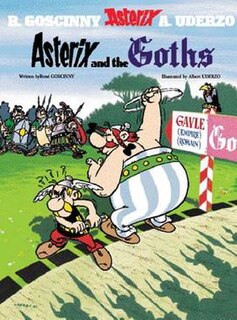
Asterix and the Goths is the third volume of the Asterix comic book series, by René Goscinny (stories) and Albert Uderzo (illustrations). It was first published in 1963 in French and translated into English in 1974.

Crimean Goths were Greuthungi-Gothic tribes who remained in the lands around the Black Sea, especially in Crimea. They were the least-known and the longest-lasting of the Gothic communities. Their existence is well attested through the ages though the exact period when they ceased to exist as a distinct culture is unknown; as with the Goths in general, they may have been diffused with the surrounding peoples. In the Fourth Turkish letter by Ogier Ghiselin de Busbecq, they are described as "a warlike people, who to this day inhabit many villages" though in the 5th century, Theodoric the Great failed to rouse Crimean Goths to support his war in Italy. At the time, it was customary to refer to a wide range of Germanic tribes as "Goths", so the exact ethnic origin of the Germanic peoples in Crimea is a subject of debate.

Hlod or Hlöd was the illegitimate son of Heidrek, the king of the Geats.

The Gothic War between the Byzantine Empire during the reign of Emperor Justinian I and the Ostrogothic Kingdom of Italy took place from 535 until 554 in the Italian peninsula, Dalmatia, Sardinia, Sicily and Corsica. The war had its roots in the ambition of the East Roman Emperor Justinian I to recover the provinces of the former Western Roman Empire, which the Romans had lost to invading barbarian tribes in the previous century.
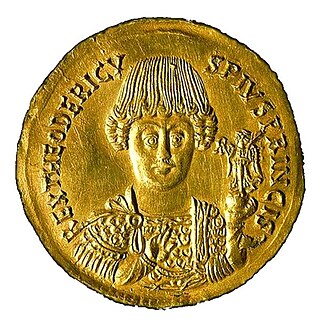
The Ostrogothic Kingdom, officially the Kingdom of Italy, was established by the Ostrogoths in Italy and neighbouring areas from 493 to 553.
Gothic Christianity refers to the Christian religion of the Goths and sometimes the Gepids, Vandals, and Burgundians, who may have used the translation of the Bible into the Gothic language and shared common doctrines and practices.

Between about 376 and 382 the Gothic War against the Eastern Roman Empire, and in particular the Battle of Adrianople, is commonly seen as a major turning point in the history of the Roman Empire, the first of a series of events over the next century that would see the collapse of the Western Roman Empire, although its ultimate importance to the Empire's eventual fall is still debated.
Theodoric Strabo was a Thervingi chieftain who was involved in the politics of the Byzantine Empire during the reigns of Byzantine Emperors Leo I, Zeno and Basiliscus. He was a rival for the leadership of the Ostrogoths with his kinsman Theoderic the Great, who would ultimately supplant him.

Gaziura, was a town in Pontus, on the river Iris, near the point where its course turns northwards. Some scholars equate Gaziura with Talaura, others with Ibora, and others with modern Turhal.
The Triarius, a tree, is a very large Eucalyptus regnans that is located in southern Tasmania, Australia. In 2010 the tree was estimated to be 86.5 metres (284 ft) tall, its diameter was 3.9 metres (13 ft), and the volume of the trunk was 219 cubic metres (7,700 cu ft).
The battle of Zela, not to be confused with the more famous battle in 47 BC, was fought in 67 BC near Zela in the Kingdom of Pontus. The battle resulted in a stunning Pontic victory and king Mithridates' successful reclamation of his kingdom. Mithridates' victory was short-lasting, however, as within a few years he would be completely defeated by Pompey the Great.
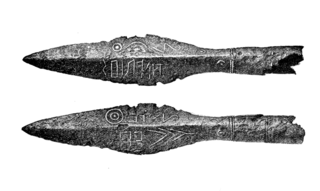
Gothic paganism was the original religion of the Goths.

















